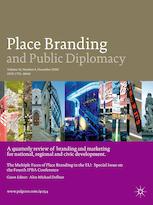This Research Insight, produced in collaboration with the Journal of Place Branding and Public Diplomacy, features a selection of recently published studies in the journal, which shed light on the strategic use of sports, cultural initiatives, and visual arts in national image cultivation.
Join us as we examine how these elements intertwine to shape place identity and strengthen the profile of cities, regions and countries. These contributions offer a nuanced understanding of the tactics and narratives that nations – and places more generally – deploy to build meaningful connections with their audiences.
Throughout this summary we have added links to the articles, so you can explore those topics further which pique your interest.
Disclaimer: Due to the large amount of articles to summarize, we have used our AI assistant to help us identify key themes and to make sure that we can cover everything. We have also used it to illustrate the article. Do you find it useful as a way to make research more accessible? ChatGPT is not perfect and does require quite a bit of editing. If you spot any errors or omissions, please let us know.
Key takeaways
- Strategic Cultural Engagement: Sports, cultural events, and visual arts are pivotal in crafting and enhancing a nation’s global image, reflecting a strategic approach to public diplomacy.
- Pandemic Diplomacy: The COVID-19 pandemic has reshaped international relations and image crafting, with “vaccine diplomacy” emerging as a key strategy in a nation’s foreign policy arsenal.
- Private Sector Influence: The case of Horsens, Denmark demonstrates the significant role of private businesses in city rebranding, pointing to the intersection of corporate initiatives and public image-building.
- Investment and Branding Interplay: Nation branding is a powerful tool for attracting foreign direct investment, illustrating how a nation’s image can sway economic interactions and investment decisions.
- Citizen Engagement and Perception: Understanding how citizens perceive their nation’s branding and diplomacy is critical, as it directly affects the success of public diplomacy and shapes the national identity.
- Visual Narratives in Nation Branding: The influence of visual narratives and media on a nation’s global image is undeniable, emphasizing the need for skilful management of visual politics in place branding strategies.
- Educational Exchanges and National Image: Educational programs and cultural exchanges, such as scholarships and the work of cultural institutes, play a significant role in shaping a nation’s image abroad and can help counter negative perceptions.
 The Role of Sports and Cultural Diplomacy in Place Branding
The Role of Sports and Cultural Diplomacy in Place Branding
The article by Yoav Dubinsky, “Country image, cultural diplomacy, and sports during the COVID19 pandemic” dissects the role of sporting events during a global crisis. It examines how the Super Bowl LV served as a platform for brand America and its image during the COVID-19 pandemic. The research highlights how countries leverage such opportunities to redefine their global image, especially in times of crisis.
In “The Olympic Games, nation branding, and public diplomacy in a post-pandemic world: Reflections on Tokyo 2020 and beyond”, Dubinsky highlights the complex relationships between international sporting events, nation branding, and public diplomacy. The insights emphasize how host countries and participants project their national identities on a global stage, thereby influencing their overall image and diplomatic relationships.
The article by Michał Marcin Kobierecki explores the utilization of sports in country pavilions during the Expo 2020 in Dubai. Many nations have recognized the potential of sports in enhancing their international reputation, aiming to influence how foreign audiences perceive their country. While such efforts have typically occurred within sporting contexts, the article investigates the use of sport as a soft power asset to promote countries during non-sporting events, using Expo 2020 in Dubai as a case study. The main argument proposed in the article is that displaying sport-related assets at non-sporting events is a viable approach to shape a state’s international image.
To further exemplify the role of public diplomacy, Yanling Zhu’s research focuses on the Guangzhou International Documentary Film Festival (GZDOC), situated within the Guangdong–Hong Kong–Macao Greater Bay Area, which China envisions as a “world-class city cluster” to bolster its global soft power. GZDOC is China’s only state-level documentary festival, established in 2003, and it navigates a delicate balance between political imperatives for regional unity and global engagement. By incorporating market-driven strategies into its state-controlled framework, GZDOC employs cultural diplomacy to reconcile the conflicting goals of regional integration and global exposure. Nevertheless, the festival faces significant challenges due to regulatory uncertainties related to censorship and intellectual property rights, reflecting the complexities of China’s soft power efforts in the Greater Bay Area.
Jenifer Chao’s work, “The visual politics of Brand China: Exceptional history and speculative future”, explores how powerful visuals can create a lasting impact, offering insights into how nations can use artistic and cultural expressions to promote their image. It recognizes that in an increasingly visual and media-centric world, understanding visual politics is crucial in nation branding.
 Place Branding and the Global Pandemic
Place Branding and the Global Pandemic
The advent of the COVID-19 pandemic brought forth a seismic shift in global dynamics, compelling nations to reevaluate their public image and diplomatic strategies. The collective research efforts of Anna Kobierecka, Boonyanit Mathayomchan, Viriya Taecharungroj, Walanchalee Wattanacharoensil, and Juan Luis Manfredi-Sánchez highlight the multifaceted repercussions of the pandemic on international relations and public image crafting.
“Post-covid China: ‘vaccine diplomacy’ and the new developments of Chinese foreign policy” by Anna Kobierecka, and “Evolution of COVID-19 tweets about Southeast Asian Countries: topic modelling and sentiment analyses” by Boonyanit Mathayomchan, Viriya Taecharungroj, and Walanchalee Wattanacharoensil, both shed light on how the pandemic reshaped diplomatic relations.
Kobierecka’s work focuses on China’s ‘vaccine diplomacy.’ It explores how China leveraged its vaccine distribution efforts to enhance its global image and further its foreign policy objectives. The research provides insights into how soft power and public diplomacy can be harnessed during global crises.
In “Evolution of COVID-19 tweets about Southeast Asian Countries,” Boonyanit Mathayomchan, Viriya Taecharungroj and Walanchalee Wattanacharoensil analyse the evolving public sentiment and discourse around Southeast Asian countries during the pandemic. The study demonstrates the power of social media in shaping perceptions of nations during crises and highlights the role of public diplomacy in addressing global challenges.
Juan Luis Manfredi-Sánchez’s research highlights the responses of China, the United States, the European Union, and Russia to the COVID-19 pandemic crisis by creating legitimacy narratives to advance their political agendas and values. These narratives involve leveraging public diplomacy tools and emphasizing the novelty of vaccines. The study reveals that presidential overexposure, social media tweets, and the use of emotional language serve as potent elements in constructing an international relations agenda. This underscores the influence of COVID-19 on political leadership and public governance, leading to the deinstitutionalization of public diplomacy. The paper provides a comparative perspective on the use of strategic narratives to achieve foreign policy goals, highlighting how political communication can have performative effects on the international order, with actions carrying significant political consequences.
 Place Branding Stakeholder Integration
Place Branding Stakeholder Integration
Inclusive place marketing is an integral aspect of nation branding. “The SWOT of Damocles: challenges in shaping inclusive place marketing audits” by Massimo Giovanardi, Maria Giulia Silvagni & Francesco Maria Barbini addresses the necessity of a methodological reflection to enhance research instruments for greater inclusivity. This case study demonstrates how researchers and consultants can collaborate with non-academic stakeholders to promote sustainable territorial development. By incorporating diverse perspectives and engaging with local communities, inclusive place marketing audits contribute to a more comprehensive and equitable nation image.
Commemoration is a vital tool in nation branding. “This is Ireland: commemoration as a catalyst for a new nation brand” by Madeline Boughton explores the transformative impact of citizen-led commemoration, such as in Ireland, on a nation’s image. This research emphasizes the importance of citizens’ active engagement in shaping their nation’s brand and identity. By participating in commemorative activities and contributing to the nation’s narrative, citizens play a crucial role in forging a cohesive and appealing national image.
Understanding how citizens perceive nation branding and diplomacy is crucial. “What diplomats do: US citizen perspectives on the work of public diplomacy” by Steven Pike investigates the role of citizens in shaping the nation brand and the interplay between the elements of brand equity. This research underscores the importance of citizen engagement in influencing a nation’s image. By analysing how citizens perceive and interact with diplomatic efforts, policymakers and diplomats can fine-tune their strategies for nation branding and public diplomacy.
Research exploring how diplomats view their work provides valuable insights into the practice of diplomacy. “My city, my love: philanthropy and rebranding of a contested city image to improve sense of place and city pride” by Ole Have Jørgensen and Martin Hannibal discusses the motives behind private businesses’ investment in city branding. The study explores how these philanthropic endeavours can influence a city’s image and the role of the local population in this process. This research uncovers the motivations and strategies of private businesses involved in city branding, offering a more comprehensive view of the partnership between the private sector and public image building.
Efe Sevin provides a review of the book titled “An Insider’s Guide to Place Branding: Shaping the Identity and Reputation of Cities, Regions, and Countries“ by Florian Kaefer. The book draws upon the author’s extensive experience and focuses on fostering connections between academics and practitioners, building bridges across various disciplines and departments, to enhance the understanding and application of place branding.
Chung-Shing Chan’s research examines how citizens perceive the potential of a “green,” “creative,” and “smart” brand for the future of Hong Kong, as promoted by the Hong Kong SAR Government. These themes are pivotal for the city, aiming to retain current residents and attract newcomers. The study focuses on local brand equity components, including awareness, perceived quality, attribute associations, loyalty, image, and uniqueness, through a survey of 751 local residents and interviews with 46 citizens. The findings reveal that the city themes encompass only some aspects of local brand equity. While respondents had varying degrees of understanding regarding these attributes across different districts in Hong Kong, their comprehension was often limited and generalized. The research also identifies potential opportunities and threats that influence residents’ perceptions, confidence, and willingness to stay in Hong Kong, especially in the face of growing regional and global competition and challenges related to talent and capital outflows and citizen participation in policymaking.
Nicola Camatti and Simon Wallington’s research explores the concept of co-creation in the context of place branding, particularly focusing on its application in Plettenberg Bay, South Africa, by Plett Tourism. Co-creation involves the active participation of various stakeholders in shaping a place’s brand, aiming to enhance its depth and legitimacy. The expectation is that these stakeholders will become enthusiastic advocates of the brand and its values. However, co-creation can be intricate in practice due to the complexity of places, limited budgets, and diverse interests. The paper explores the processes of co-creation initiated by Plett Tourism, offering insights into a comprehensive understanding of co-creation that extends beyond the initial stages, emphasizing continuous engagement with stakeholders. This study also explores the intersection of co-creation and internal place branding, shedding light on the multifaceted dynamics involved.
 Place Branding and Power
Place Branding and Power
In the realm of international relations, the complex interplay of nation branding and power takes centre stage in this collection of research endeavours. The featured studies, authored by Kadir Jun Ayhan, Daniel Buarque, Sameera Durrani, and Olga Krasnyak, provide a multifaceted exploration of the nuanced dimensions of power in the global arena.
Soft power, a prominent concept in international relations, is dissected in “Soft power is rare in world politics: Ruling out fear- and appetite-based compliance” by Kadir Jun Ayhan. This article approaches the concept from the perspective of power recipients, focusing on the motives for compliance and the nature of soft power. Ayhan’s work reveals the intricate dynamics between power wielders and power recipients in the context of soft power. It challenges traditional notions of power dynamics in global politics and offers a fresh perspective on how nations can use soft power to influence their image and international relationships.
Daniel Buarque’s research explores Brazil’s global image, particularly regarding its perception as a “serious” player in world politics. To gain insights into this, the study focuses on the views of the foreign policy community in great powers, recognizing the significance of these subjective opinions in shaping a nation’s international prestige. Utilizing a theoretical framework of international status and drawing from elite interviews, the paper reveals that Brazil’s seriousness is a matter of debate among great powers. However, it argues that Brazil is more likely to be considered serious when it aligns with the interests of these powerful states. This research on Brazil’s seriousness contributes to discussions in international relations and offers hypotheses for understanding the concept’s implications.
Sameera Durrani’s research introduces the concept of “Negative Watch,” offering a fresh perspective on soft power by focusing on the loss of a nation’s reputation and its communicative aspects. This novel concept expands discussions surrounding negative place branding and introduces a model comprising an index with unfavourable narrative typologies and a heuristic model outlining outcomes resulting from reputational decline. Negative Watch can function as a self-assessment tool for nations to monitor and address their diminishing reputation, thereby averting more severe consequences. It also facilitates the systematic evaluation of external actors, including allies and adversaries, aiding strategic decision-making in international relations and public diplomacy.
Olga Krasnyak provides a book review of Natalia Tsvetkova’s work titled “The Cold War in Universities: U.S. and Soviet Cultural Diplomacy, 1945–1990.” The review highlights the ongoing interest in the Cold War era among scholars and practitioners. It emphasizes that the core issues that led to tensions between superpowers in the twentieth century, such as safeguarding national interests, expanding influence, and promoting specific values and ideas, have remained unchanged. The review suggests that how stronger powers employ methods and instruments to exert influence on weaker nations is a subject of intense examination. It also notes that the higher education system’s transformation is a critical area where stronger powers manifest their political intentions regarding client states.
 Place Branding Competitiveness
Place Branding Competitiveness
In a globalized world, where nations and cities vie for recognition and appeal, the dynamics of branding and competitiveness hold paramount significance. This collection of research endeavours by Evelyn Hendriana, Khairil Wahidin Awang, Raja Nerina Raja Yusof, Lesego Alicia Keimetswe, Nancy Xiuzhi Liu, and Stephen Andriano-Moore examine the intricate tapestry of image, perception, and strategic communication in the context of nation branding and city promotion.
The research by Evelyn Hendriana, Khairil Wahidin Awang, and Raja Nerina Raja Yusof explores the interplay between country image and regional ethnocentrism in motivating students considering neighbouring countries for their studies. While previous studies have emphasized the significance of host country and institution images in international student decision-making, this research investigates the context of regional student mobility where regional ethnocentrism may also play a role. The study examined Indonesian middle- and upper-class high school students using purposive sampling and analysed 431 valid responses through PLS-SEM. The findings of this study confirmed the interrelationship between various elements of a country’s image. However, only the country’s cognitive image and personality had a positive influence on the institution image, which subsequently affected students’ intentions to study in a neighbouring country. Regional ethnocentrism was found to partially moderate the relationship between the elements of the country brand and the institution image. This research provides practical insights for host countries and institutions to tailor their marketing strategies effectively for targeting students from neighbouring countries.
Lesego Alicia Keimetswe’s research investigates the impact of the Chinese Government Scholarship Program (CGSP) and the Confucius Institute at the University of Botswana (CIUB) on China’s national image in Botswana, focusing on soft power perspectives. Using a mixed-method approach, combining qualitative and quantitative methods, the study collects data from various sources, including an online questionnaire completed by fifty CGSP recipients and CIUB students. The findings reveal that the educational and cultural activities offered by CGSP and CIUB have contributed to dispelling negative perceptions of China in Botswana. However, their impact on China’s image is limited as they primarily target students and do not reach the general population. The research suggests that the Chinese government could enhance its efforts by offering scholarships explicitly aimed at countering negative Western narratives, which continue to fuel unfavourable perceptions in Botswana, inadequately addressed by CIUB and CGSP.
Nancy Xiuzhi Liu and Stephen Andriano-Moore’s research analyse the role of promotional videos in city branding, focusing on Ningbo, a coastal city in China’s Zhejiang province. The study employs the narrative paradigm as a conceptual framework to evaluate the city’s repositioning efforts in comparison to successful cases of promotional videos. The findings indicate that Ningbo’s branding initiatives require improvement in several areas, including enhancing its competitive edge, ensuring consistency in positioning, refining storytelling, and establishing uniqueness. A notable contribution of this research is the incorporation of thematic multimodal discourse analysis to assess the visual, audio, and textual effects of promotional videos in city branding. The study’s significance lies in its potential to serve as a model for promoting second and lower-tier cities, enhancing the overall competitiveness of such urban areas.
In “A battle for foreign perceptions: Ukraine’s country image in the 2022 war with Russia”, Seow Ting Lee analyzes the 2022 Russo-Ukraine War through the lens of country image, incorporating perspectives from public diplomacy, soft power, and nation branding. The paper adopts integrative and longitudinal approaches, spanning three decades from Ukraine’s independence in 1991 to the recent conflict. Using a case study methodology, the research employs sentiment analysis through Leximancer to assess Ukraine’s country image in international news media discourse during key periods: its independence, the 2014 Revolution of Dignity, and the 2022 Russo-Ukraine War. The findings indicate a strengthening of Ukraine’s country image over time, effectively delegitimizing the 2022 Russian invasion and garnering strong international support.
In a world where economic power is deeply intertwined with diplomatic influence, the research by John Schoeneman and Jami Fullerton in “Exploring relationships between nation branding and foreign direct investment” is a key contribution. This study investigates the intricate connections between foreign direct investment (FDI) and nation branding. Schoeneman and Fullerton’s work emphasizes how nation branding efforts can be a significant factor in attracting FDI. Beyond this, it highlights the various facets of a nation’s image that can influence the decisions of foreign investors. In an age where nations compete for investments on a global scale, understanding these nuances is essential for shaping effective nation branding strategies.
Browse all research articles in the latest issue of Place Branding and Public Diplomacy here
 Place Branding and Public Diplomacy
Place Branding and Public Diplomacy
Published by Palgrave / Springer
Place Branding and Public Diplomacy is the first and only journal to concentrate on the practice of applying brand strategy and other marketing techniques and disciplines to the economic, social, political and cultural development of cities, regions and countries.
Edited by James Pamment and Robert Govers | See editorial board
Looking for more on place branding research? Visit our place brand theory hub


